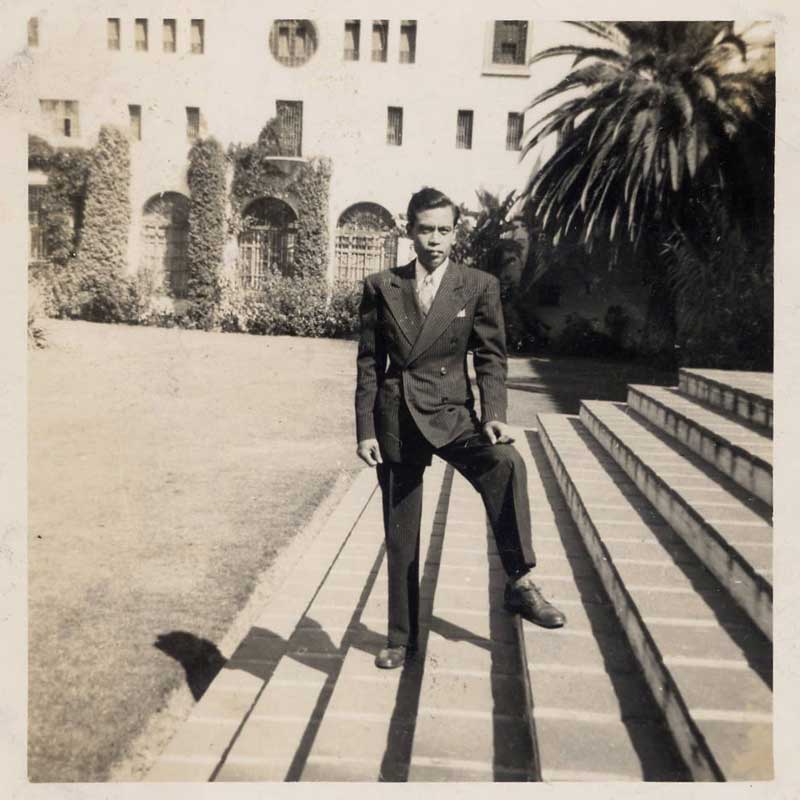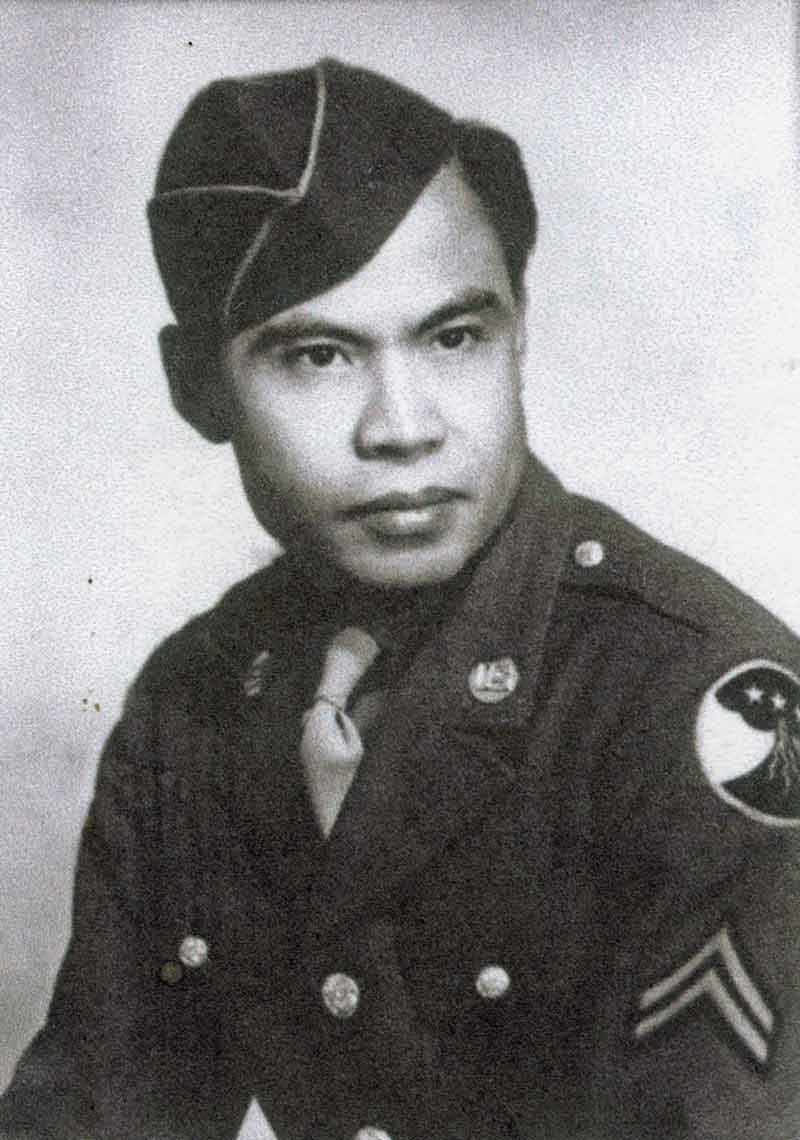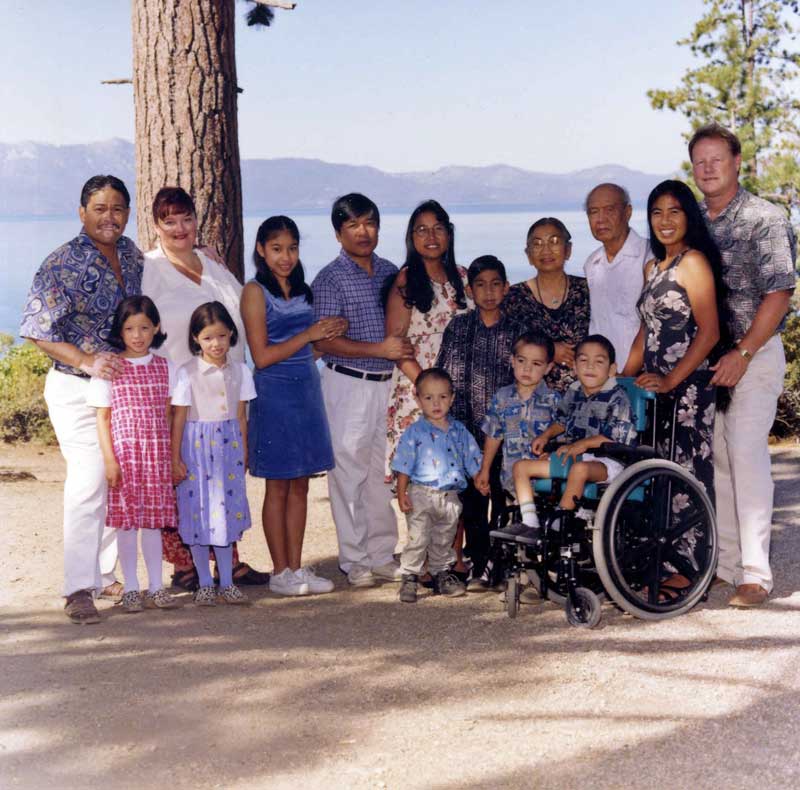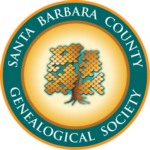Exhibit: Santa Barbara Asian American & Pacific Islander Heritage, 1870s-1970s
Ambrose Palmones Baggao (1912-2007)
Veteran, Family Man, Community-Oriented
By Susanne Mori

Ambrose Baggao on the Courthouse steps. Courtesy of the Baggao family.
Early Life
Ambrose Baggao was born on 12 Dec 1912 to Catalino Baggao II and Marcela Palmones. He was the eldest of 9 children. The family resided in Pidigan, a municipality in the Filipino province of Abra. Beginning in 1899, the Philippines were a territory of the United States. Despite poor treatment by the Americans, many young men chose to immigrate to the United States. In February 1931 at the age of 19 Ambrose left Manila and arrived at the port of San Francisco in March. He listed Chualar as his US address. Although not a US citizen, the territorial status of the Philippines allowed Ambrose to travel here in the same manner as if he were. He was the only person in his family to immigrate and once here, like many immigrants, he helped support family members in the Philippines.
Military Service
According to his daughter, Beverlyn, Ambrose worked various jobs in Southern California. His first jobs were picking produce north of Santa Barbara county. He worked his way south and by April 1931 and until Dec 1935 he worked bussing tables at a restaurant in the La Arcada building. He also studied English and history by attending night school at Santa Barbara Jr High. In 1936, he moved to Hollywood to work for a Mrs. Koster but returned to Santa Barbara to work at the El Paseo Cafe in 1937. He resided at 1729 Chino Street until 1940 when he moved to 815 Santa Barbara St. In Jan 1941, he began working for Mrs. Milton Wilson at 620 Hot Springs Road. He worked there until April 4, 1942 when, according to his daughter, he was inducted into the Army Air Corp of either the Philippines or the United States. He continued his military service by enlisting or reenlisting with the US Army Air Corp in December of 1945. The Army Air Corp later became the US Air Force where he served until his retirement in 1969 with the rank of Master Sergeant. At the time of his retirement, he was serving at Vandenberg AFB.
After retirement from the military, he worked for a short time at the federal prison in Lompoc and then 10 years with the postal service. Through hard work, he and Paulina were able to purchase several homes in the Santa Barbara area. His first purchase was in Lompoc and he later purchased two homes on Valdez Ave in Goleta.

Ambrose Baggao, Master Sergeant in the US Army Air Corp that later became the US Air Force. Courtesy of the Baggao family.

Ambrose and Paulina Baggao with their children and grandchildren. Courtesy of the Baggao family.
Family
Ambrose was married twice. He met both of his wives in the Philippines. His first wife, Maria, died while giving birth to his son Arville at March Air Force Base (Riverside). According to his daughter, Maria approached him in a dream and told him that he should marry her cousin who was studying to be a nurse. In fact, his second wife, Paulina, is a first cousin to Maria. Ambrose and Paulina were married in 1956.
He and Paulina had two daughters, Beverlyn and Charlotte. His daughters were also born at Air Force Bases. Beverlyn was born at Clark AFB in the Philippines and Charlotte was born in Taiwan. His time in the Air Force also allowed the family to spend time in the Philippines where they interacted with extended family on the paternal side and learned Ilocano, one of several languages spoken there.
Community
Community was important to the Baggao family. They were active in Filipino Community Centers in both Lompoc and Santa Barbara. They were one of the original families in the Lompoc Filipino-American Club, and Beverlyn is still active there. Once they moved back to Santa Barbara in the ‘70s, they were active in the Santa Barbara Filipino Community Association. For a while there was also a Goleta Club. One year Ambrose ran for president but lost when his children voted against him.
The Santa Barbara club purchased their building for $16,000 in the 1940s and leases the front portion to a restaurant at affordable rent. Beverlyn remembers the center being a place to hang out and be Filipino and learn about Filipino food and dance. She also remembers watching the adults play poker upstairs. One large celebration was the Philippine Independence Day in June when they would party at someplace fancy like the Miramar.
Ambrose passed away August 2007 and is interred at Calvary Cemetery in Santa Barbara.
